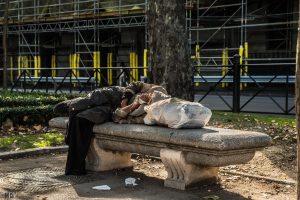3.7 Discrimination
Discrimination against homeless people is categorized as the act of treating people who lack housing in a prejudiced or negative manner because they are homeless. Other factors can compound discrimination against homeless people, including discrimination on the basis of race, gender, sexuality, age, mental illness, and other considerations (Wikipedia, 2025).
Discrimination in the form of social ostracization, institutional prejudice, and punitive legislation impacts homeless individuals, leaving well-documented negative effects such as reducing reported rates of well-being, fracturing perceived social support, decreasing access to goods and services, increasing substance abuse, and prolonging the duration of homelessness (Wikipedia, 2025).
Past research has shown that identifying with multiple groups can buffer against the negative consequences of discrimination on well-being; it remains to be seen whether such strategies protect the well-being of people who are homeless. There was an investigation set on to look into this issue in a longitudinal study of 119 individuals who were homeless. The results showed that perceived group-based discrimination at T1 was associated with fewer group memberships and lower subsequent well-being at T2. There was no relationship between personal discrimination at T1 on multiple group memberships at T2. The findings suggest that the experience of group-based discrimination may hinder connecting with groups in the broader social world — groups that could potentially protect the individual against the negative impact of homelessness and discrimination.

A large body of work demonstrates that people who are homeless also experience disproportionate rates of health problems and associated social disadvantages (Rosenthal et al., 2006; Echenberg and Jensen, 2009; Scutella et al., 2012). Pervasive discrimination experienced by people who are homeless, particularly discrimination based on access to accommodation and goods and services, contributes to the high rates of poor health (Phelan et al., 1997; Lynch and Stagoll, 2002). Moreover, the discrimination that homeless individuals face is perceived as legitimate (Fiske et al., 2002), not only by the public but also by individuals who experience homelessness themselves.
Even though individuals who are homeless are perceived as struggling and in need of care and compassion (Kidd, 2004; Benbow et al., 2011; Shier et al., 2011), there is also evidence that homeless individuals are not perceived as fully human (Harris and Fiske, 2006). Research has shown that homeless people as a group are seen as neither competent nor warm, and thus form “the lowest of the low” (Fiske et al., 2002). This elicits the worst kind of prejudice – disgust and contempt – and can make people functionally equivalent to objects (Harris and Fiske, 2006). This further enhances the perceived legitimacy of negative treatment against the homeless and, in turn, further compromises an individual’s ability to cope with discrimination.
In sum, because homeless individuals face discrimination that is perceived as legitimate and targeting them for many different reasons, we predict that these individuals’ well-being will be negatively affected. Consistent with this, both qualitative and quantitative work describes the negative impact of discrimination for the homeless on their well-being (Phelan et al., 1997: Lynch and Stagoll., 2002: Kidd, 2007) and homeless individuals describe the experience of discrimination as making the transition out of homelessness and into employment and stable housing significantly more complex and challenging (Milburn et al., 2006; Piat et al., 2014).

